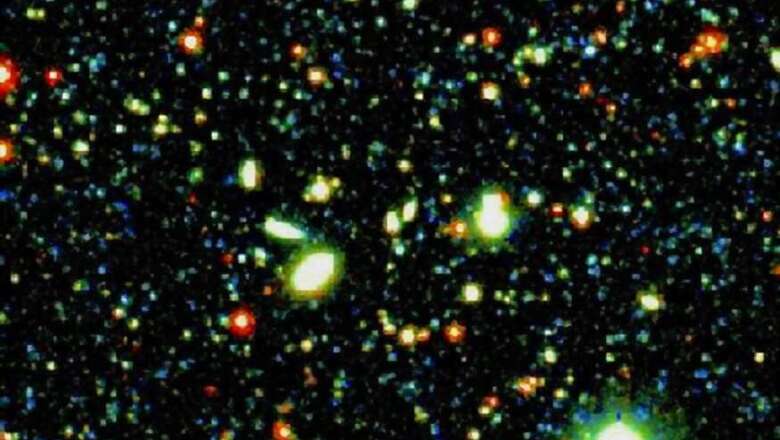
views
In a first, astronomers have spotted close encounter between two hyper-luminous starburst galaxies -- astoundingly bright and spectacularly massive galaxies - in the early universe. "Finding just one hyper-luminous starburst galaxy is remarkable in itself. Finding two of these rare galaxies in such close proximity is truly astounding," said Dominik Riechers, an astronomer at Cornell University in Ithaca, New York. Astronomers captured these two interacting galaxies, collectively known as ADFS-27, as they began the gradual process of merging into a single, massive elliptical galaxy.
The ADFS-27 system has approximately 50 times the amount of star-forming gas as the Milky Way, said the study published in the Astrophysical Journal. "Much of this gas will be converted into new stars very quickly," Riechers said. "Our current observations indicate that these two galaxies are indeed producing stars at a breakneck pace, about one thousand times faster than our home galaxy," Riechers said.
News18.com Presents Tech and Auto Awards 2017 | Selfie Smartphone of the Year: Nokia 8 or Oppo F3 Plus? Vote And Win
The ADFS-27 galaxy pair is located approximately 12.7 billion light-years from Earth in the direction of the Dorado constellation. At this distance, astronomers viewed this system as it appeared when the universe was only about one billion years old. "Considering their extreme distance from Earth and the frenetic star-forming activity inside each, it's possible we may be witnessing the most intense galaxy merger known to date," Riechers said.
Astronomers speculate that this merger may eventually form the core of an entire galaxy cluster. Galaxy clusters are among the most massive structures in the universe. The researchers first detected this system with the European Space Agency's Herschel Space Observatory. It appeared as a single red dot in the telescope's survey of the southern sky. These initial observations suggested that the apparently faint object was, in fact, both extremely bright and extremely distant.
News18.com Presents Tech and Auto Awards 2017 | Design of the Year: Apple AirPods or Samsung Frame? Vote and Win
Follow-up observations with the Atacama Pathfinder Experiment (APEX) telescope confirmed these initial interpretations and paved the way for the more detailed observations. With its higher resolution and greater sensitivity, the Atacama Large Millimeter/submillimeter Array (ALMA) observatory in Chile precisely measured the distance to this object and revealed that it was two distinct galaxies.
The pairing of otherwise phenomenally rare galaxies suggests that they reside within a particularly dense region of the universe at that period in its history, the astronomers said.
Watch: Motorola Moto X4 First Look | The Improved Moto G5s Plus


















Comments
0 comment